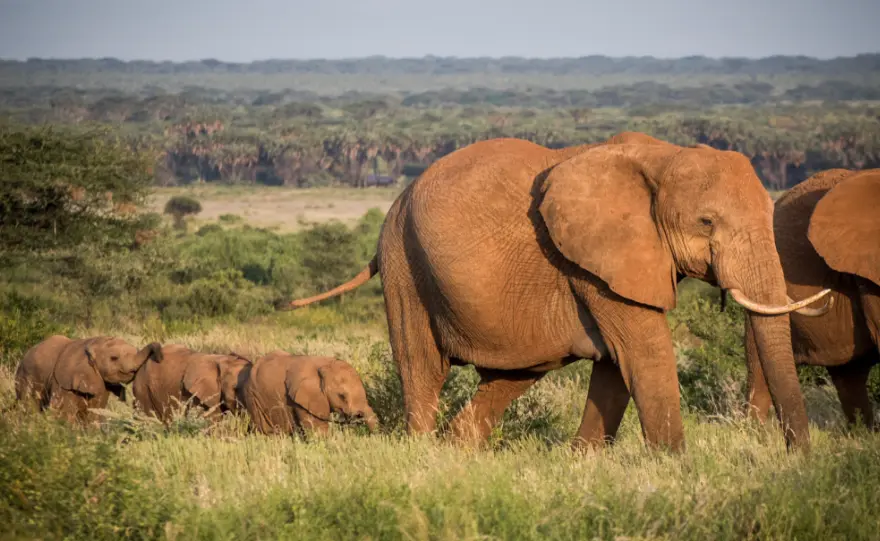Written by Jane Wynyard.
Imagine a curious wild bull elephant poking his trunk into your car window, or a group of lively but very large young elephants playfully jostling around your vehicle. This is a common experience for Save the Elephants (STE) researchers in Samburu National Reserve, northern Kenya, who spend up to eight hours a day monitoring the behaviour and movements of the world’s largest land mammal.
Save the Elephants has been studying elephants in this beautiful protected reserve – renowned for its dramatic landscape and rich abundance of wildlife – for more than 26 years. With an intimate knowledge of over 700 elephants identified by ear patterns and tusk shapes, STE’s researchers are helping unravel the mysteries of elephant society and giving elephants a voice. From family structures to mating preferences, every observation builds data that helps reveal the complexities of elephant behaviour.

The Samburu elephant population is one of the best studied in the world, and the data collected by researchers over the years has charted the devastating impact of poaching, human-elephant conflict, and habitat loss. With each new insight, the researchers help forge strategies to protect wild elephants from harm.
This on-the-ground data collection has contributed to more than 120 peer-reviewed papers by Save the Elephants’ researchers. Their research not only deepens our understanding of elephants but also highlights how much in common elephants have with humans. Surprisingly, elephants share striking similarities with humans – they possess complex brains, vast intelligence, engage in rituals to mourn their dead and celebrate birth, and form deep social bonds.
And just like humans, elephants can find themselves in trouble. A favourite resident of Samburu National Reserve is the curious, car-loving bull, Anwar. Not only has he cracked one or two windscreens with his tusks over the years, but he’s known for frequenting nearby lodges, eating their Acacia trees and drinking water from their private pools in front of ecstatic tourists.
There is, however, a more serious side to monitoring Anwar’s movements. During the drought, the Save the Elephants’ Rapid Response team were kept on their toes trying to keep him and other bull elephants out of harm’s way after they raided a nearby town in search of food and water, smashing through fences and tearing down trees. Anwar’s celebrity status in the park meant nothing to the angry locals whose properties were being damaged. With other male elephants killed in human-elephant conflict just a few months earlier, Save the Elephants acted swiftly to guide Anwar back to the safety of the reserve.

Keeping track of wild elephants that wander into nearby towns or roam for miles across vast landscapes is only possible thanks to advanced technology. Save the Elephants utilises satellite tracking collars to gain insights into elephants’ perspectives, and currently tracks more than 450 elephants across Africa and up to 30 in Kenya. Researchers can follow the elephants’ movements on the STE WildTracks App which, alongside Earth Ranger software, is revolutionising real-time monitoring, enabling researchers to protect elephants, like Anwar, more effectively. In 2024, STE created an online platform for collaboration on elephant tracking with a database of more than 3,200 collars from the past 30 years, uniting elephant researchers and conservationists from 14 organisations across 12 countries. Mapping and analysis tools have been developed and deployed across multiple sites in Kenya, Uganda, South Sudan, and Malawi, with training and hands-on support given to multiple conservation partners.
Save the Elephants is also keeping elephants safe by fostering coexistence between elephants and humans. Kenya is facing rapid human population growth, with a 59.4% increase between 2000 and 2020, which has led to the shrinking of elephant habitats as human settlements and infrastructure expand. Finding sustainable ways for people and elephants to coexist is becoming an urgent challenge and keeping elephants safely away from subsistence farms, through the use of methods like beehive and chili rage fences, is a major focus of Save the Elephants’ Coexistence Programme.

Most recently, a groundbreaking, nine-year study co-authored by Save the Elephants, revealed that elephants approaching small-scale farms in Kenya avoid beehive fences housing live honey bees up to 86% of the time during peak crop seasons, helping to reduce human-elephant conflict for local farmers and boost income. The study was conducted by STE in collaboration with the Wildlife Research and Training Institute (WRTI), Kenya Wildlife Service (KWS), and the University of Oxford.
Research is crucial to unlocking insights into the lives of elephants. Most recently, researchers from Save the Elephants and Colorado University have started to decode the complex vocalisations of elephants and discovered that they appear to have names for each other. In other areas, PhD researchers are working to reveal the decision-making processes of matriarchs and shedding light on the inner workings of elephant society. And this is just the beginning. With new technology like artificial intelligence and genetics, we’re about to learn even more about these keystone species and their critical role in our ecosystem.

So if you’re ever lucky enough to visit Samburu National Reserve, keep an eye out for the Save the Elephants’ vehicles. Inside you’ll find a team of hard-working researchers, helping to ensure the survival of elephants for generations to come.

